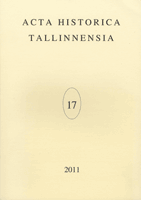OLLI ORJA SÄÄL KOSKIL… ORJA- JA VABADUSETEMAATIKA SIBERI EESTLASTE VÄLJARÄNDAMISJUTTUDES
THERE WERE SLAVES OUT THERE... THEMES OF SLAVERY AND FREEDOM IN THE MIGRATION NARRATIVES OF SIBERIA’S ESTONIANS
Author(s): Astrid TuiskSubject(s): History
Published by: Teaduste Akadeemia Kirjastus
Keywords: Estonia; Estonian History; WERE SLAVERY ; FREEDOM ; MIGRATION NARRATIVES OF SIBERIA’S ESTONIANS
Summary/Abstract: The article analyses the migration stories of Estonians who settled in Siberian villages established during the late nineteenth- and early twentieth-century surge in migration for agrarian purposes. My informants were descendants of these Estonian emigrants. The narratives were collected during the Estonian Folklore Archives expeditions carried out between 1991 and 2005. The discussion thus covers a tradition from a specific period. The study takes oral history as its point of departure. In Estonia, research into oral history is often based on studies into text and traditional storytelling. Oral history accounts, archive texts and analyses of the past are all constructional by nature: in the construction of both the texts and studies, certain cultural norms and skills are applied. The informants of today conceive the life of their ancestors in Estonia and their migration to the new homeland with metaphorical images of national, social and personal freedom. Opposition to landlords, representations of land, slavery and freedom and the established attitudes based on these were part and parcel of the migration movement since its beginnings. While for the previous generation of emigrants the symbols and images may have been associated with the national fight for freedom, hopes for freedom and dreams of a free life in a new place, the opposition to landlords of German descent, or the establishment of social justice, then for my informants today these are mainly beautiful romantic myths. The informants emphasize the hardships in Estonia and the social injustice that their ancestors had to endure but the focus has clearly shifted from the description of specific circumstances to the opposition ‘bad life in Estonia’ versus ‘good life in Siberia’. The images from a specific era that had a specific narrow sense have acquired a more general meaning. From this specific topic and this specific period of oral history have evolved a tradition to speak in a specific way and a general collective experience which are based on collective memory and serve the community’s interests. When speaking about the topic, specific metaphorical images have been used and clearly outlined and fixed attitudes have been established. Thus in these stories two different levels – the personal and the collective historical experience of people – become merged. In contemporary narratives, the attitudes related to leaving homeland are uniform. The decision to emigrate was reached by the people themselves, but the difficult conditions in Estonia at the time were certainly a contributing factor.
Journal: Acta Historica Tallinnensia
- Issue Year: 2011
- Issue No: 17
- Page Range: 055-071
- Page Count: 17
- Language: Estonian

